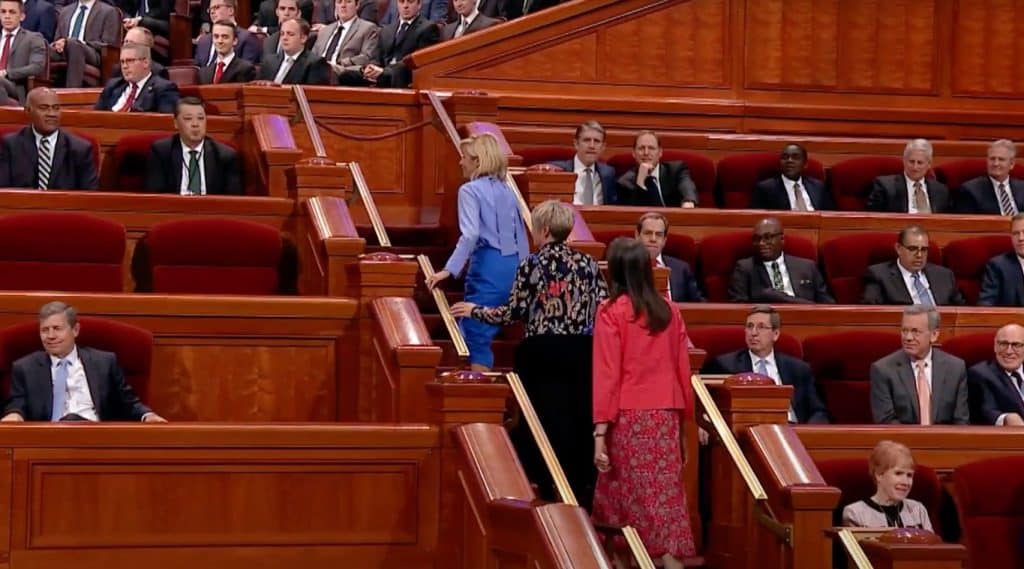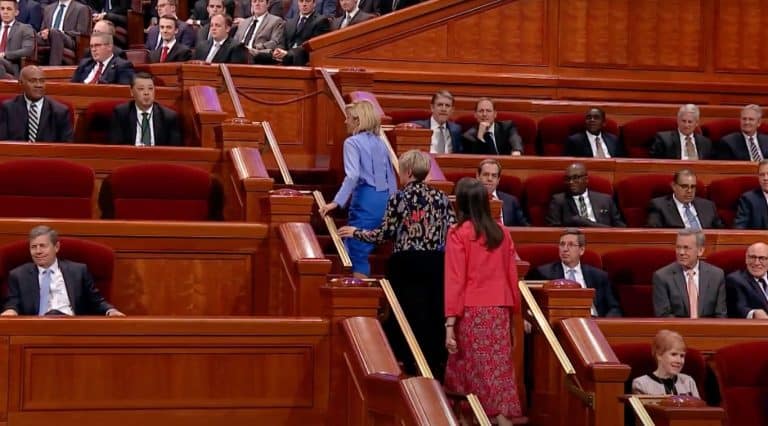Male leaders of the Church of Jesus Christ of Latter-day Saints (LDS) are called General Authorities or simply leaders—never men leaders—but the church uses the term women leaders to describe the nine women serving on the General Presidencies of the Relief Society, Young Women and Primary organizations. While these nine women leaders tend to be talented women with stellar leadership skills, their leadership potential is crippled by a system designed to elevate men’s voices, priorities and choices over women’s.
Here are nine barriers that need to be resolved before women leaders can reach their full leadership potential in the LDS church.
1. Women leaders are outranked by men.
A woman is working at a disadvantage in any church setting because she’s outranked by every priesthood office-holding man present. Only men are given the title, General Authority. Women do not have enough authority to be called General Authorities. While church leaders have recently begun teaching that women have some sort of access to priesthood, despite lack of priesthood ordination and office, they maintain that all final decisions belong to priesthood office holders with priesthood keys, and that all women, including women leaders, lack priesthood keys. Any progress women may make is subject to male veto. In contrast, no male General Authority is ever subject to supervision or veto from a woman, so listening to women is largely optional for them.
2. Women leaders only lead certain demographics, and even within those demographics, their authority is limited.
While men may govern every demographic of church member, including the women leaders themselves, women leaders are only granted authority over women and children. And even that authority is quite minimal; a women leader has less authority over women and children than a local bishop. Local male leaders such as bishops may supervise, bless, interview, discipline, administer over, and minister to woman and children in ways forbidden to even the highest-ranking women in the church.
3. Women leaders have no direct reports.
Who do women leaders lead? Women have no place in the church’s chain of command. Male General Authorities supervise local priesthood leaders, but the women of the General Relief Society, Young Women and Primary presidencies do not supervise anyone at the local level. The women of ward Relief Society, Young Women and Primary presidencies report to male bishops, who report to male stake presidents, who report to male Area Authorities and General Authorities. Women leaders have no say in the people called to staff the local units of the organizations they supposedly lead, and no means to require implementation of their initiatives by local units.
4. Women leaders are selected by and accountable to men.
Like their local counterparts, women leaders at the general level are selected by and accountable to men, putting them in a better position to serve as female spokespersons for the brethren rather than advocates for women.
5. Women leaders consult while men lead.
Women leaders hold positions similar to contracted consultants at secular organizations. They provide valuable expertise and offer important feedback, vital to the success of the church. Yet they cannot make final decisions for the organization and may not be promoted within its ranks. They are not part of the priesthood hierarchy of the church; they are outsiders.
6. Women leaders do not meet with the First Presidency.
Even in a consulting role, the influence of women leaders is limited by lack of access to the First Presidency of the LDS Church. The Salt Lake Tribune recently uncovered that since women leaders were added as minority members of church councils in 2015, they have stopped meeting one-on-one with the First Presidency. Adding women to the councils of the church was the right move; otherwise, men counsel alone and only request female feedback when they happen to realize they need it. An occasional opportunity to give feedback is inadequate to compensate for excluding women from the early brainstorming and final decision-making stages of a group process. Women need to be at the table the whole time. That said, there is no reason why admittance to church councils should preclude one-on-one meetings, especially when we consider that…
7. Women leaders are vastly outnumbered by men.
Including one or two women on a council is better than banning women altogether, but it’s only barely better. BYU’s own research demonstrates that when women are outnumbered by men, they participate less. If the brethren really want to hear women’s voices on these councils, they need to involve more women. Likewise, only nine women leaders rotate through General Conference speaking slots with over a hundred men, so female voices are drowned out at General Conference, giving masculine perspectives a greater impact on church teachings and doctrine.
8. Women leaders serve for a shorter period of time than most of their male counterparts.
The calling of General Relief Society President began as a lifetime commitment like the male calling of Apostle, but the male First Presidency eventually decided they had power to release a women leader, and over the decades since, has shrunken a women leader’s term of office to the point that today a woman leader serves for only five years. If her ideas differ from male leaders who have already been working toward their own priorities for decades, it’s hard for a woman to make a mark on theology and policy during the comparatively brief time between when she is plucked from obscurity and called as a woman leader and when she is released from her calling. Five years is a reasonable term limit, but the problem lies in the lack of a level playing field with male Apostles who serve for life and male Seventies, Presiding Bishoprics and Auxiliary Presidencies, who also have term limits but tend to rotate between powerful callings, accumulating experience, connections and influence over time. A new apostle is usually already a known entity to church members because he has already spoken in General Conference during his previous general-level callings. There are so few women leader callings that women generally don’t rotate through general-level callings—one shot and they’re out—which leads me to the next point:
9. Women leaders are eligible for only nine general-level callings.
Including women in approximately equal proportions with men in councils and General Conference is a logistic impossibility while only nine women but over 100 men are considered eligible to participate. But why only nine women? The church benefits from having a larger, more diverse group of men at its helm incorporated into a variety of general leadership callings such as Apostle, Presiding Bishopric, Auxiliary Presidency and Seventy. Likewise, the church would be better served by including an equivalent number of women in a greater variety of general-level callings to better reflect the diversity of the female population of the church and provide more opportunities for women to serve in different capacities over time.

More about LDS Women Leaders on Mormonland Podcast
I recently had a great discussion about the status of women leaders in church hierarchy on the Mormonland podcast with managing https://exponentii.org/wp-content/uploads/2021/12/IMG_5173-scaled-1.jpg David Noyce and religion reporter Peggy Fletcher Stack of the Salt Lake Tribune.
Listen to the podcast
Will a top LDS women’s leader ever again be seen as a ‘13th apostle’? | Episode 336
Read the transcript
‘We consult, but we don’t lead’ — Top women’s leaders are ‘outsiders’ in the LDS hierarchy
Did you know Exponent II is a 501(c)3 nonprofit organization? Support Exponent II.










10 Responses
There has been so, so, so much talk about how women do have the Priesthood, so we need to stop asking for it – but that’s so silly when you realize that almost nothing has changed structurally in the past decade for women since Ordain Women. The men just decided to toss a breadcrumb and say fine, you can use our special man-word to describe yourselves, too. Women have priesthood power!
And yet they changed nothing and are confused why not enough women happily accepted it. You lay it all out so very clearly why this system is not empowering to women in any level.
I loved your podcast interview, too!
Preach!
Well written and comprehensive essay! One thing that really bothers me is the way the female leaders facebook pages are run.
For a few years, as you know, they have had facebook pages for each of the top female leaders. But when the leader gets released, the new leader takes over that facebook page, and the facebook page is ” renamed” with the new leader. I think this is so, so disrespectful to these sisters.
Why not allow these leaders to retain their page? The church could just have a General RS Page and then the leaders contribute to it, or Young Women or Primary page, then have their own individual pages that are there after the calling ends! For example would be great to follow Sis Eubank. But her page has the name of the sister who took her place.
When they change the names with the release, they have silly childlike videos of the departing sister sitting on an office chair, turning around and then the new leader sirring on the chair. Can you imagine this happening with men? This makes it confusing to follow the page because if someone sees a post from before the current sister, it appears as if the post author is the current leader, so that can be frustrating as well!
The gospel library app General Conference talks section should also list the current/ living leaders, separate from those who have died. Right now, the First Presidency and Q of 12 are listed / pinned. But all the other current leaders talks are listed with all the past leaders who are deceased.
< I did suggest the gospel app make a distinction between current and previous leaders and list female leaders on a prominent place so their talks aren’t mixed with those who have passed or are released. >
Hopefully they will add more filtering options for this.
Thanks again!
The way they are doing it with the new person in the calling just replacing the old one, implies that the women are completely interchangeable. As if women have no individual personality or identity, only the role they currently fill. Reminds me of some of the early polygamous leaders who “gave no more thought to getting a new wife than [they did] to getting a new cow.” It is the same job and one woman will do it exactly the same as the next, so no need to let them have anything of their own that is really theirs. Men of course, have individuality, and keep their own identity from childhood, through their mission, career and all church callings. While for women, we have one identity as our father’s daughter, then another one as some man’s wife, any wife of his has exactly the same identity, Mrs John Doe. So, we are used to not having any identity and perfectly interchangeable. [End sarcasm]
I really want the church to lay out, specifically, what I can do with my divinely given priesthood (sans men) that I couldn’t do without it. I suppose the immediate answer would be callings, but I’d still have to be set apart by a man, to apply any power to doing that calling, so I question whether that counts. There are specific things men and boys who have the priesthood can do outside of any set-apart calling. I also want to know what this power that I have, as Sister Dennis references, allows me to do that women in other churches can’t do. Because those women are praying and receiving revelations and leading and teaching, etc. Without a list of “here’s what you can do with the priesthood that you cannot do without the priesthood,” telling me that yeah, sure, you have the priesthood too is meaningless.
Doing research as to the “restoration” of priesthood to LDS men, the facts get pretty sketchy. There is no power there that everyone else on earth has, too. Including all women. They seem to be working overtime to keep the lack of spiritual power a secret. Other churches don’t have fake priesthood, so it’s not an issue for them women. If they want to be involved and lead, they can.
The top-down transfer of power means that the end goal is to “hoard power” with fewer people telling others what to do and more people “being obedient” and doing what they are told. It means quicker decision-making with less input from diverse bodies. It means less contention because “resistance is futile” – and more quiet quitting because “staying and resisting can be futile”.
I think a lot of familial trauma occurs because the priesthood leadership models “hoarding power” and doesn’t teach priesthood holders to transfer power/authority/decision-making with respect well to spouses or children (news flash: D&C 121 on repeat does not a “21st century respectful power holder” make.). I recognize that this model of “priesthood empowerment” also contributes to more stable households where men are more present in the family and in supporting the family in some countries and in some areas.
For my part, I preside. I make decisions. My children find it most efficient to “direct report” to me about care tasks branded as “chores and homework”. I am learning to respectfully insist on that level of respect. I see myself as the most powerful/privileged member of my family – with the imperative to “share power” and “redirect power” and “empower” family members in every why that I can and I am always studying systems and other sources of information to figure out how to do so in ways that create “win-win situations”.
I don’t think I have the correct questions, let alone any answers.
I want to be a part of this organization
We need you every where
Excellent points, April!
One of the hardest days at church for me was because of #1 in your list. All the talks were about prophets. A sister missionary talked about prophets in the old testament, and I was sad that she likely didn’t know about the prophetesses in the old testament because they’d been written out of our curriculum. Then our new area authority was gushing about how he got to have lunch with the prophet, and how the other prophets seers and revelators sustain President Nelson as the prophet. So do the other General Authorities. So do the Female Leaders. It felt like such a punch in the gut that he couldn’t group women with the other general authorities. If he can’t do that, how could he possibly see that women can be prophets just like they were in the Old Testament? Yanno, it’s just our canonized scripture. These dudes want me to be jealous of how women were respected thousands of years ago?!? Ugh.